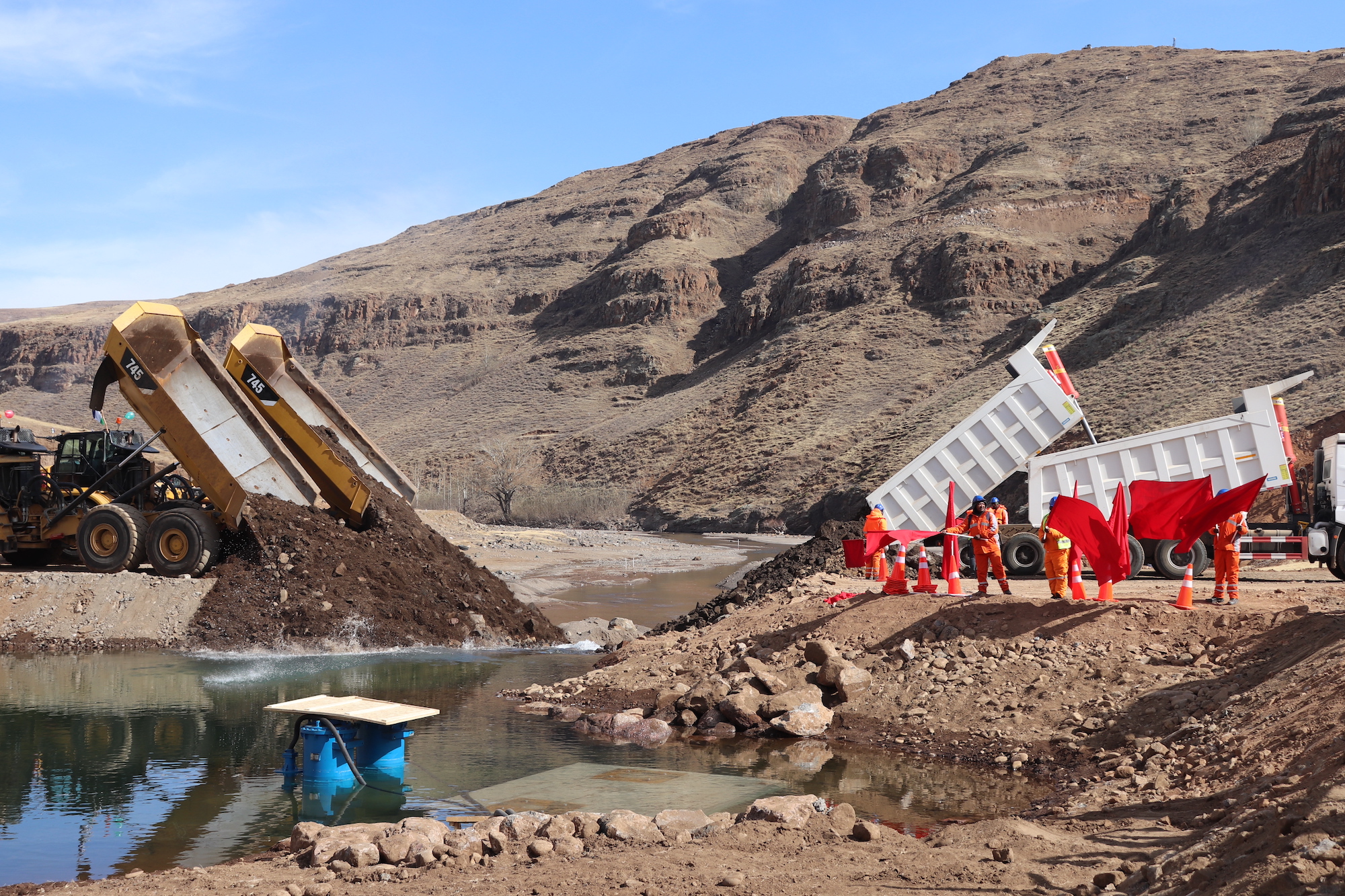 Dumping of materials to close the river flow. Images courtesy of LHDA
Dumping of materials to close the river flow. Images courtesy of LHDAThe Lesotho Highlands Development Authority (LHDA), along with consultants and contractors involved in the Polihali Dam project, marked a crucial milestone in its construction on Friday. The event commemorated the successful diversion of the Senqu River by the pre-cofferdam, and the subsequent diversion of the river into and through the diversion tunnels ahead of the construction of the cofferdam upstream of the Polihali Dam wall.
Tente Tente, Chief Executive of the LHDA, lauded the achievement, stating: " This is quite an achievement to the engineering fraternity. It is a key moment of the construction programme because unless this happens, no other elements of dam construction can happen. We are proud of everyone who has had a hand in this work. It is indicative that Phase II, just a couple of months after being officially opened by our principals, is indeed now going full steam ahead. Our consultants and contractors have hit the ground running, and we are all excited for what this means for the project, and for Lesotho and South Africa.”
Tente emphasized the significance of the timing, adding: " It had to happen now because the timing of it during the winter season without rain was critical. If you miss it by a week or two, you may miss the entire window by another twelve months."
Polihali Dam requires extensive excavation of the foundations before work begins in bringing it up in height. The works in the foundations require dry access to enable the rock to be excavated down to sound rock, to allow grouting of the rock to be undertaken where required beneath the dam and to allow the construction of a plinth beam which will form the water-tight seat for the upstream impermeable, concrete facing of the main dam wall.
To provide this dry environment, a cofferdam is to be built upstream of the main dam to protect the main dam works from floods until the main dam concrete face is high enough to be free of such floods. In turn, to allow the coffer dam to be built there is a pre-cofferdam upstream of the cofferdam. This has the task of diverting the river through the diversion tunnels and thus around the cofferdam and the main dam foundations.
Chris Hall, Project Manager of the Matla a Metsi Joint Venture, the entity overseeing the dam's construction, explained the sequence of events following the pre-cofferdam closure: "Now the Senqu River level will rise and the water will then enter the diversion tunnels to bypass the dam construction site. Whilst the riverbed is drained of water the coffer dam foundations will be excavated within the river and the flanks of the valley. The plan is to complete the cofferdam before the end of October this year, according to the current master programme, and then to start on the main dam in earnest."
The construction of the Polihali Dam, a concrete-faced rockfill dam, commenced in November 2022 under the M7.68 billion contract awarded to the SUN Joint Venture. This consortium includes partners Sinohydro Bureau 8 and Sinohydro Bureau 14 from China, Unik Civil Engineering from South Africa, and Nthane Brothers from Lesotho. Several subcontractors, including Melki Civils and Plant Hire, MECSA Construction, SIGMA Construction, and Kunming Engineering, are also contributing to the project's success.
The Polihali Dam is set to create a reservoir on the Senqu and Khubelu rivers with a surface area of 5053 hectares. The ambitious infrastructure plan includes a spillway, an intake tower, bottom outlet works, a compensation outlet structure, bridges, roads, and a mini-hydropower station.
In terms of its impact, the Polihali Dam boasts an additional storage capacity of 2,325 million cubic meters for the LHWP, significantly boosting the current annual supply rate capacity. This increase will cater to South Africa's escalating water demands, also enhancing Lesotho's domestic water supply and reducing its reliance on electricity imports.
The successful achievement of this construction milestone in Phase II of the Lesotho Highlands Water Project reflects the project's progress following the completion of Phase I in 2003.